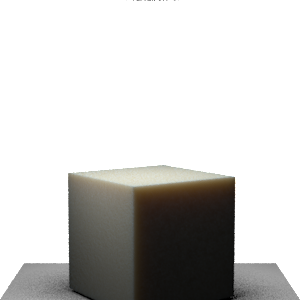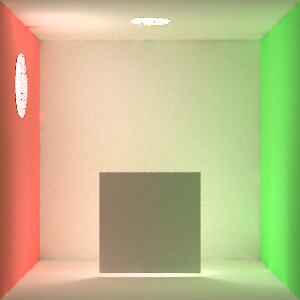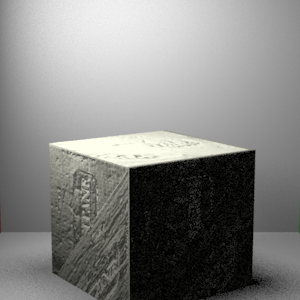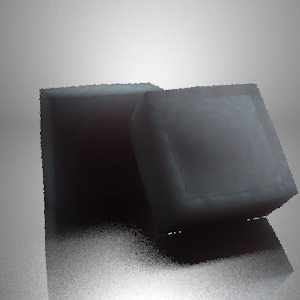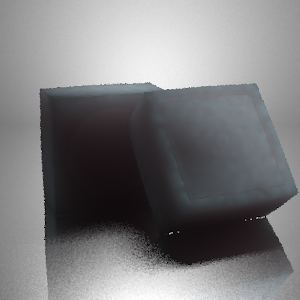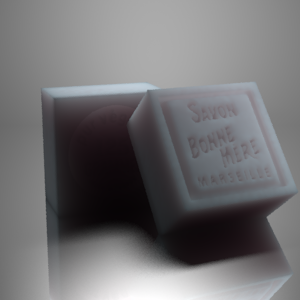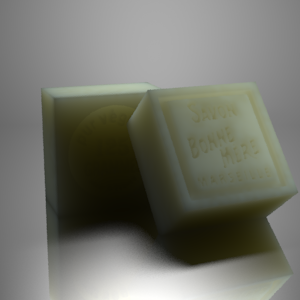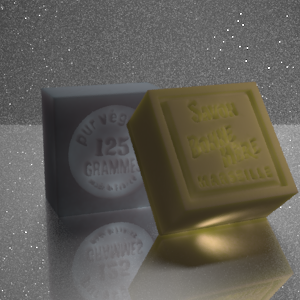Final Project
Group Members
Andrew Yen
Laurie Kim
Intro
For our project, we intended to render a realistic image of soap, accurately capturing its subsurface scattering properties and surface geometry.
Techniques Implemented
Subsurface Scattering
In order to model the subsurface scattering of light through soap, we followed the implementation outlined in "A Rapid Hierarchical Rendering Technique for Translucent Materials" by Jensen et al. The basic approach was to do a two-pass rendering process. The first pass was to calculate irradiance samples on locations over the subsurface scattering object. On the final rendering pass, the irradiance sample values are used to calculate a dipole approximation of light scattering through the translucent material.
We added a Subsurface class to pbrt to represent a subsurface scattering object. The Subsurface class stored references to all the primitives that made up the object, as well as maintained an octree to efficiently store irradiance samples over the object. The octree was used to quickly approximate far away samples when the solid angle subtended by the samples was less than a specified threshold. We took uniform samples using stratified sampling over the primitives that made up each object. The number of samples was first determined by the area of the primitive divided by a disk with diameter of the mean free path. We then increased the number of samples as necessary in the final images to eliminate artifacts.
In calculating the exitant radiance at a point on the subsurface scattering object, the Subsurface class omitted the single scattering term since for highly scattering objects with albedo close to 1, the multiple scattering term dominates. We also assumed a diffuse radiance at the surface as light exits the material. We modified the SurfaceIntegrator interface to allow various surface integrator classes to implement how to calculate the irradiance at points on a surface. The irradiance samples were calculated during the preprocessing step prior to rendering. In particular, we modified the DirectLighting integrator to uniformly sample all lights to approximate the irradiance at a point. We also added a SubsurfaceScattering integrator to calculate irradiance by taking into account the global illumination in the scene using photon mapping.
During the rendering pass, each integrator needed to be modified to react differently when encountering a subsurface scattering primitive. The diffuse term came from the dipole approximation described above, but the glossy and specular terms in the BRDF functioned as before.
Early test of a subsurface scattering block using "skim milk" parameters |
A thin back-lit block exhibiting no subsurface scattering |
The same thin back-lit block exhibiting subsurface scattering |
|
|
|
Models and Geometry
We modeled our soaps after the Marseille style Bonne Mere soaps from L'Occitane:

We originally modeled our soap as a relatively simple block using Maya. We intended to use bump mapping to show the surface details. However, we found that using bump maps didn't generate as dramatic and interesting surface details as we had hoped for. Subsurface scattering tends to smooth out small bumps on the surface, thus making bump mapping a less effective technique.
Original subsurface scattering block |
With bump map and no subsurface scattering |
With bump map and subsurface scattering |
|
|
|
We decided to use displacement mapping instead to model the writing and decorations on the soap. We used scanned images of the soap surfaces as displacement maps to perturb the subdivided mesh in Maya.
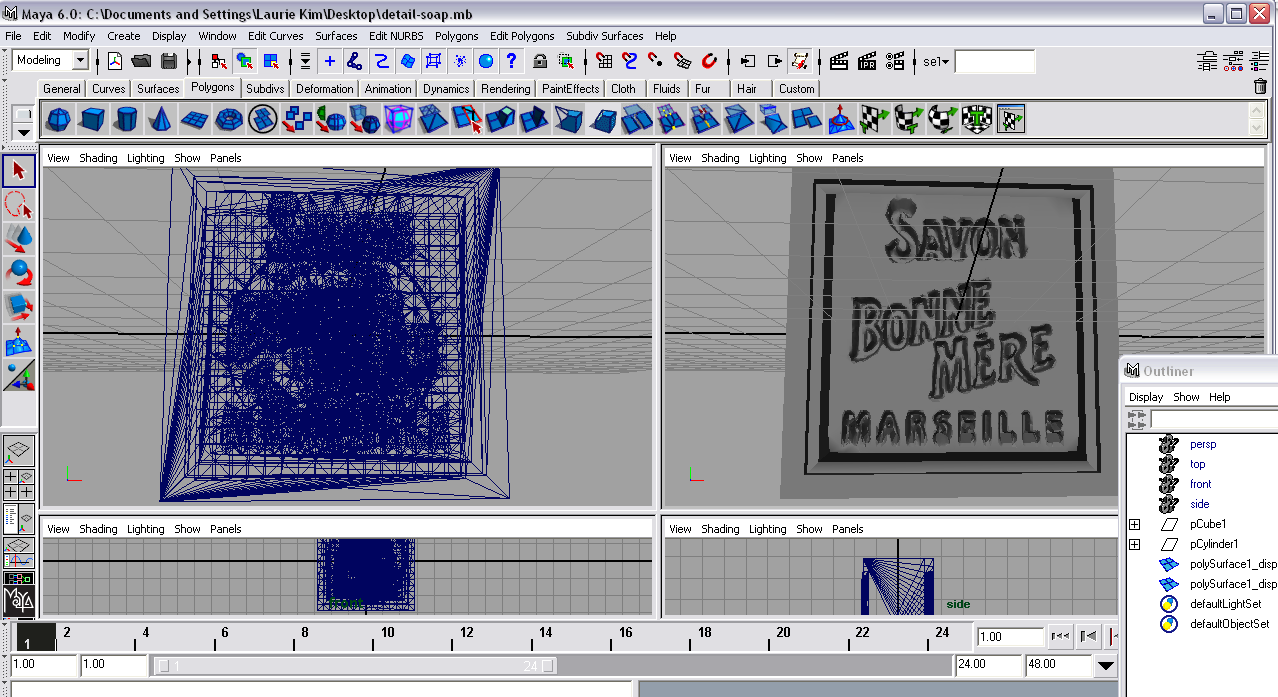
Modeling surface features as actual geometry also helped produce more accurate scattering effects around the details.
Color Matching
Another part of the challenge of reproducing the look of our soap was in figuring out the scattering parameters to match the soap colors. The parameters that are necessary for the dipole approximation are the reduced scattering coefficient and the absorption coefficient. We started out with a target diffuse material color and a target dominant scattering color that we wanted to aim for. We then used the equation in Jensen et. al's "A Practical Model for Subsurface Light Transport" which related the diffuse reflection coefficient to the reduced albedo of a material to solve for the reduced albedo. Since this equation is not easily invertible, we plotted 100,000 points along the Rd vs. albedo curve and linearly interpolated the albedo value from the target material Rd value for the RGB channels. We then used the ratios of the scattering color to modulate the maximum diffuse mean free path of some known material such as those listed in [2]. These new mean free path values were then used to calculate the scattering coefficients.
These are example results rendered using our calculated parameters for the same material and scattering colors but different mean free path values modeled after measured materials:
Modeled after apple |
Modeled after cream |
Modeled after skim milk |
|
|
|
These are the final parameters we settled on for several soap colors:
|
|
|
Technical Challenges
The subsurface scattering algorithm was fairly challenging to implement and debug. There were some details that weren't very clear in the papers that we had to work through, such as how to summarize children nodes in the octree and how to fit the calculated values into the broader surface integrator framework.
Another major challenge we came across was noise in the form of light leaks and bright spots when using photon mapping.
|
|
|
Because our scene consists of diffuse objects on top of a highly specular surface, the noise produced by photon mapping tended to produce random bright spots on the subsurface scattering objects. Due to the two pass nature of our subsurface scattering approximation, errors in the photon map affected the appearance in somewhat unpredictable ways and it was difficult to track down the cause of the errors. We tried a number of things to try to decrease the bright spots and noise in our image, such as increasing the number of photons and using irradiance caching to interpolate between irradiance sample calculations. In the end, we managed to reduce but not completely eliminate the noise.
High resolution image, rendered with photon mapping

Results/Conclusions
Our Final Image, rendered with direct lighting, which we submitted for the Rendering Competition. We decided to submit this version instead of the the photon mapping version due to its pleasing appearance.
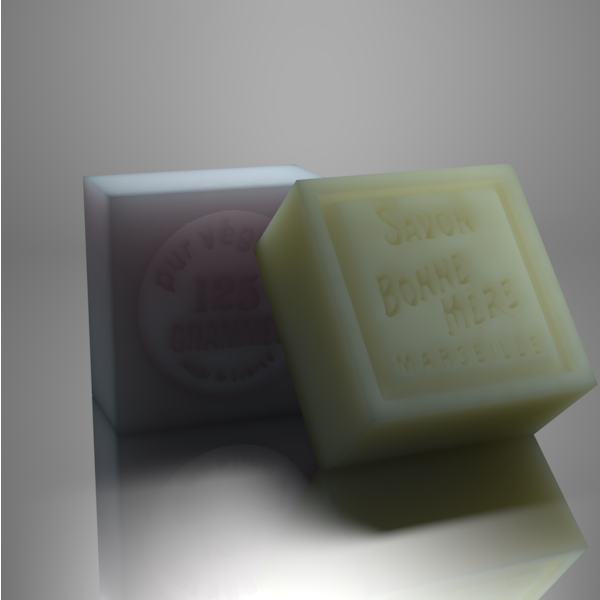
We were happy with the results of our final images, as we thought the subsurface scattering effects made a dramatic difference versus the plain matte material.
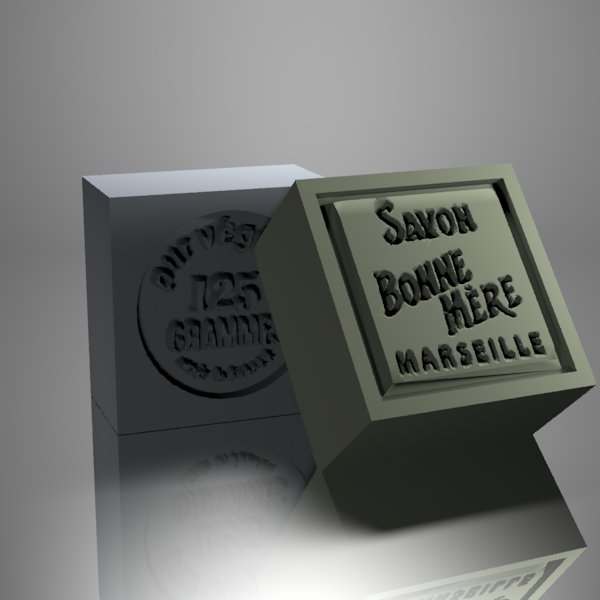
With more time, we would have liked to more closely model the actual translucency of our reference objects, as well as the finer surface features such as scratches and imperfections on the surface of soap. Another interesting effect we would have liked to investigate was non-homogeneous materials often used in soap.
Work Breakdown
We think our team contributed fairly equally to this project. Laurie handled the photon mapping, irradiance sampling, and surface integrator changes as well as creating the models and displacement maps. Andrew handled the subsurface scattering approximations, bump mapping, and color matching calculations.
Source Code
Original Proposal
References
[1] Pat Hanrahan and Wolfgang Kreuger: "Reflection from Layered Surfaces due to Subsurface Scattering". Computer Graphics (Proceedings of SIGGRAPH 1993), July 1993.
[2] Henrik Wann Jensen, Stephen R. Marschner, Marc Levoy and Pat Hanrahan: "A Practical Model for Subsurface Light Transport". Proceedings of SIGGRAPH 2001.
[3] Realistic Image Synthesis Using Photon Mapping by Henrik Wann Jensen.
